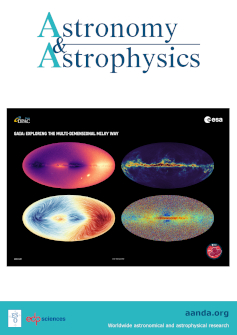埃利亚斯 2-27 圆盘中通过引力不稳定性进行的角动量传输
IF 5.4
2区 物理与天体物理
Q1 ASTRONOMY & ASTROPHYSICS
引用次数: 0
摘要
引力不稳定性被认为是年轻原行星盘角动量传输的主要驱动力之一。埃利亚斯 2-27 周围的圆盘为引力不稳定性的作用提供了一个独特的例子。它年轻而巨大,在尘埃连续发射中显示出两个突出的旋臂,在分子线数据中显示出全局非轴对称运动学特征。在这项工作中,我们利用 ALMA 对 13CO 线发射的档案观测,通过引力不稳定性产生的运动学特征(即 "GI 摆动")来测量埃利亚斯 2-27 系统的角动量传输效率。假定角动量是由观测到的螺旋结构传输的,并利用先前得出的动力盘质量测量值,我们发现的角动量传输量对应于 α 粘度 α = 0.038 ± 0.018。这个值意味着中心恒星的吸积率为 log10 Ṁ⋆ = -6.99 ± 0.17 M⊙ yr-1,很好地再现了一个观测值 log10 Ṁ⋆,obs = -7.2 ± 0.5 M⊙ yr-1。我们发现的极好的一致性进一步证明了引力不稳定性是该系统角动量传输的主要驱动力。本文章由计算机程序翻译,如有差异,请以英文原文为准。
Angular momentum transport via gravitational instability in the Elias 2–27 disc
Gravitational instability is thought to be one of the main drivers of angular momentum transport in young protoplanetary discs. The disc around Elias 2−27 offers a unique example of gravitational instability at work. It is young and massive, displaying two prominent spiral arms in dust continuum emission and global non-axisymmetric kinematic signatures in molecular line data. In this work, we used archival ALMA observations of 13CO line emission to measure the efficiency of angular momentum transport in the Elias 2−27 system through the kinematic signatures generated by gravitational instability, known as “GI wiggles”. Assuming the angular momentum is transported by the observed spiral structure and leveraging previously-derived dynamical disc mass measurements, the amount of angular momentum transport we found corresponds to an α-viscosity of α = 0.038 ± 0.018. This value implies an accretion rate onto the central star of log10 Ṁ⋆ = −6.99 ± 0.17 M⊙ yr−1, which reproduces the one observed value of log10 Ṁ⋆,obs = −7.2 ± 0.5 M⊙ yr−1 very well. The excellent agreement we have found serves as further proof that gravitational instability is the main driver of angular momentum transport acting in this system.
求助全文
通过发布文献求助,成功后即可免费获取论文全文。
去求助
来源期刊

Astronomy & Astrophysics
地学天文-天文与天体物理
CiteScore
10.20
自引率
27.70%
发文量
2105
审稿时长
1-2 weeks
期刊介绍:
Astronomy & Astrophysics is an international Journal that publishes papers on all aspects of astronomy and astrophysics (theoretical, observational, and instrumental) independently of the techniques used to obtain the results.
 求助内容:
求助内容: 应助结果提醒方式:
应助结果提醒方式:


